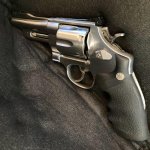I was under the impression that it was designed for that. Optics are great, but irons are the fail safe when there is an issue with the optic. The rmr seems like it cowitnesses but I'm not 100% sure. Hopefully someone else can chime in.
The RMR and SRO co-witness with the iron sights. Hopefully in the past half a year or so they’ve fixed the issue with the factory suppressor night sights shooting WAY high as I had to switch out the rear sights on my 2.0 COREs (and have seen it on dozens of COREs) to get POA/POI. If that’s still the case I wouldn’t worry too much about having to switch out the front sight.
I can’t say for sure with the 2.0 compact, but one of my fellow instructors has been fighting the DeltaPoint Pro (DPP)/CORE game for a while with a 4.25” CORE and he uses the Leupold DPP rear sight with a Dawson 0.460 front sight. It sits well at the bottom of the window with the fiber optic visible but not taking up too much of the window.
My department requires backup iron sights and I agree with that policy because I wrote it. That said, the iron sights should be unobtrusive and sit at the bottom of the window so as not to obscure the view. The term “Co-witness” is frequently misunderstood and misused. There can be a “true” co-witness, where the reticle, when centered in the optic window, is in alignment with the iron sights. My department’s rifles currently use a “lower 3rd co-witness” where the iron sights sit low in the window. The optic reticle, when placed low in the window, is still generally aligned with the iron sights, but that’s a by-product of the zero process, not an efficient way to use the optic.
Visible iron sights on optic-equipped pistols perform three functions. They offer a backup precision aiming method in the unlikely (if run right) event the optic doesn’t function. They also provide a way to confirm the zero of the optic on a regular basis without having to shoot. If one can’t find the dot during the presentation, the muzzle should be raised enough to see the front sight, which is then lowered into the rear notch. Either the dot comes into view or the irons are aligned. In all other circumstances the iron sights should be ignored and if you have to continually use the irons to find the dot you aren’t doing it right. A true co-witness in a pistol optic is the mark of someone who doesn’t know what they are doing. The iron sights should be as low as possible but still visible and useable.
In short, there are ways to get the performance you want out of your DeltaPoint Pro setup. It will cost you money but will be cheaper than getting a new optic. The DeltaPoint Pro isn’t my favorite optic, and the base height is a big reason why. That said, it’s a good optic and I ran the 10,000 round test and wrote the report that resulted in its approval for my department.
I’ve spend a very large portion of the last three years working on pistol optics in a professional capacity and while I’m by no means the final word I have a fair amount of research, experience, and probably a six-digit round count through optic-equipped handguns. If you have any questions please feel free to ask and I’m more than happy to offer my thoughts.



